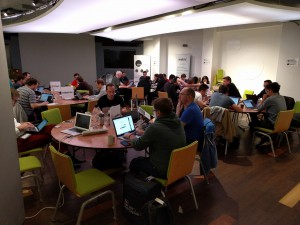 TADHack-mini London was larger that last year with 88 people through the door, with 18 hacks, with more diversity of people involved, and many more hacks winning that required little coding. This is an important trend; the tools and platforms continue to democratize telecoms so more and more people can use it their applications, services and business models. We had a total of $8k to distribute including a Trossen Phantom X Hexapod.
TADHack-mini London was larger that last year with 88 people through the door, with 18 hacks, with more diversity of people involved, and many more hacks winning that required little coding. This is an important trend; the tools and platforms continue to democratize telecoms so more and more people can use it their applications, services and business models. We had a total of $8k to distribute including a Trossen Phantom X Hexapod.
We’ll review all the hacks in detail in coming weeks. Here is a quick summary of the winners in the order they were presented. You can see the rest of the quality hacks here.
Stephen Sale from Analysys Mason created “My First Hack” a primary research automation service using Telestax and Dialogic. This was his first ever hack, we recorded it on Saturday as he had family commitments on Sunday. But in only a couple of hours with coding skills long forgotten he created an application that would help him in his work. He won the Telestax/Dialogic prize for best first hack.
SPAN Services created the hack Mayday using Telestax and Dialogic. Mayday is an application developed over the RestComm platform, which provides features such as audio/video call, chat, annotation and co-browsing. The application supports iOS & Android operating systems and the Web. The demonstration of this application is implemented using an e-commerce electronic store application, where the use of Mayday application has been conceptualized. They won the Telestax/Dialogic prize for best customer Service innovation. Here a link to their remote entry.
Torrey Searle demonstrated the Integration of Midori into a Cisco Spark room with many impressive capabilities and won the Cisco prize. Here’s the link to his remote submission, parental discretion advised.
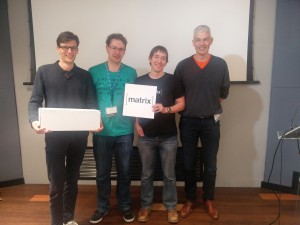 Steven Bakker, Timo Uelen and Bart Uelen created the hack Babelonio, a mulilingual chat using decentralized messaging. Resources used included Matrix, speech recognition and Google Translate. They won the Matrix prize of a Phantom X Hexapod Mk3.
Steven Bakker, Timo Uelen and Bart Uelen created the hack Babelonio, a mulilingual chat using decentralized messaging. Resources used included Matrix, speech recognition and Google Translate. They won the Matrix prize of a Phantom X Hexapod Mk3.
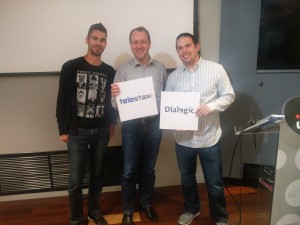 Sebastian Schumann’s hack ‘Contact Sentry’ using Telestax Restcomm and Dialogic XMS. It provided inbound call filter based on network address book and programmed white-list through Slack. He won the Telestax/Dialogic prize for best overall hack.
Sebastian Schumann’s hack ‘Contact Sentry’ using Telestax Restcomm and Dialogic XMS. It provided inbound call filter based on network address book and programmed white-list through Slack. He won the Telestax/Dialogic prize for best overall hack.
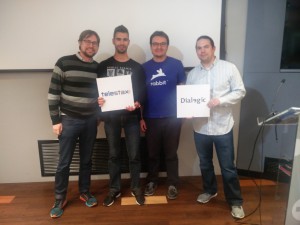 Roderick Hodgson and Alex Francois created the hack Distillate using Telestax, Dialogic, Apidaze. The hack enables you to have a record and keep track of the key topics in your conversations. Receive an SMS with keywords from your WebRTC audio conversations. They won both the Apidaze prize and Telestax/Dialogic prize for best use of AI.
Roderick Hodgson and Alex Francois created the hack Distillate using Telestax, Dialogic, Apidaze. The hack enables you to have a record and keep track of the key topics in your conversations. Receive an SMS with keywords from your WebRTC audio conversations. They won both the Apidaze prize and Telestax/Dialogic prize for best use of AI.
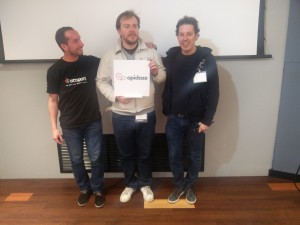 Mike Dauphinais created the hack Cupido using Cisco Spark and Apidaze. Its a merge conflict manager: in case of local changes that might create a merge conflict, a room is created to discuss about it. He won prizes from both Cisco and Apidaze.
Mike Dauphinais created the hack Cupido using Cisco Spark and Apidaze. Its a merge conflict manager: in case of local changes that might create a merge conflict, a room is created to discuss about it. He won prizes from both Cisco and Apidaze.
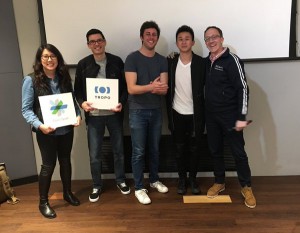 Brant Wang & Sacha Nacar created the hack BigBro using Cisco Spark. An anti-cyber-bullying bot for chat rooms. They won the Cisco prize.
Brant Wang & Sacha Nacar created the hack BigBro using Cisco Spark. An anti-cyber-bullying bot for chat rooms. They won the Cisco prize.
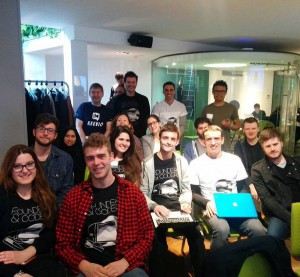 I would also like to mention the hack ‘confidant’ by the Founders and Coders WebRTC course students: Tasnim Sultanah, Mireia Sangalo Tomas, Ivan Gonzalez, Jack Tierney, Eleanor Re’em, Virginie Trubiano, Robert Francis, Katherine Bowler, Andrew MacMurray, Jack Murphy, Elias Malik, Francesco Moro, Sam Houston, Owen Turner-Major, Eoin McCarthy, and Ben Gesso. Which used of course WebRTC, Tropo, Telestax and Dialogic. Confidant is a hack which comes from a real life requirement brought to them by a Charity and an NHS Trust who want to enhance youth mental health counseling services using a community of volunteers on related university courses. It demonstrates the feasibility of using WebRTC to provide better access to support services and at the same time give supervised students credit for professional experience gained by volunteering their time. They’d only just learned about WebRTC and were creating a hack they intend to bring to market.
I would also like to mention the hack ‘confidant’ by the Founders and Coders WebRTC course students: Tasnim Sultanah, Mireia Sangalo Tomas, Ivan Gonzalez, Jack Tierney, Eleanor Re’em, Virginie Trubiano, Robert Francis, Katherine Bowler, Andrew MacMurray, Jack Murphy, Elias Malik, Francesco Moro, Sam Houston, Owen Turner-Major, Eoin McCarthy, and Ben Gesso. Which used of course WebRTC, Tropo, Telestax and Dialogic. Confidant is a hack which comes from a real life requirement brought to them by a Charity and an NHS Trust who want to enhance youth mental health counseling services using a community of volunteers on related university courses. It demonstrates the feasibility of using WebRTC to provide better access to support services and at the same time give supervised students credit for professional experience gained by volunteering their time. They’d only just learned about WebRTC and were creating a hack they intend to bring to market.
The rest of the hack are reviewed in this weblog.

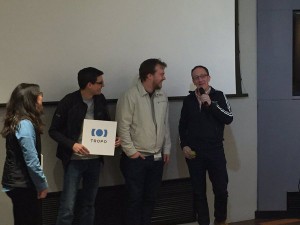
2 thoughts on “Quick Summary of TADHack-mini London 2016 and the Winners”
Comments are closed.